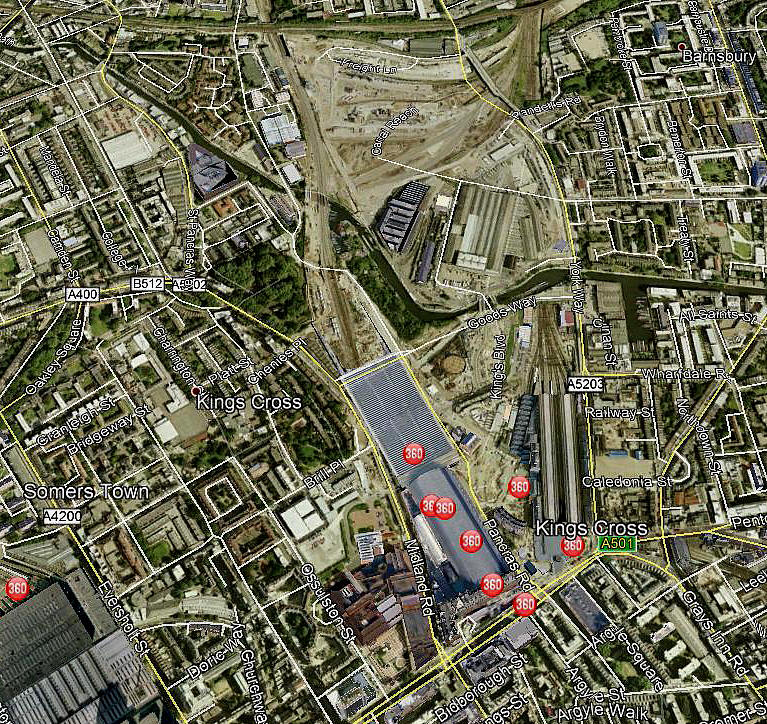St Pancras
St PANCRAS: One-off landing site
Note: This picture was obtained from Google Earth ©
As can be seen the area north of both St Pancras and Kings Cross was being demolished for redevelopment, and presumably the coal yard was in this area. Quite possibly near to the gas works?
Operated by: RAF Trans-Atlantic record flight team
Location: Coal yard roughly N, probably just NE of station?
Period of operation: One day, (possibly two?) in May 1969
NOTES: As so very often, by taking a ‘broad-brush’ approach to compiling this ‘Guide’, it seems to pay off. I discovered the existence of this ‘flying site’ within an account in Trident – A History by Dr Frank McKim. (This concerns the DH.121 airliner – not the American missile). “On the 26th April 1969 the Daily Mail announced that they were organising an air race during the week 4 – 11 May 1969, to commemorate the fiftieth anniversary of the first non-stop crossing of the Atlantic by Alcock and Brown.” A race that could be won in both directions, but with no competitor being able to win more than one prize.
Isn’t it astonishing to read about this in the 21st century, when the newspaper industry in the UK has been pretty much wrecked by figures such as Robert Maxwell and Rupert Murdock. In 1969 newspapers still had considerable standing and much respect and the often lacklustre minions of TV management had yet to appear. Can you imagine a TV station supporting such a project?
“The race was to be from the top of the Post Office tower in London to the top of the Empire State Building in New York, or vice versa.” According to Dr McKim three BEA Trident pilots, Captain Tony Angus, Senior First Officer J Collins and First Officer T Henderson worked out a detailed and workable plan for the attempt to be made using a BEA Trident. A brilliant concept which surely would have put BEA on a global stage regarding publicity?
Needless to say the project was dismissed by BEA management with footling excuses. In the end the RAF and the Royal Navy took up the challenge and won the race in both directions.
“East to west, by an RAF Harrier, time 6 hours 12 minutes. West to east, by a Royal Navy Phantom, time 5 hours 11 minutes.” The Phantom also broke the New York to London record in 4 hours 46 mins.
The RAF Harrier (possibly XV741?) took–off from a coal yard adjacent to St Pancras station. The Phantom landed at WISLEY in SURREY and a Royal Navy Wessex helicopter transferred the ‘runner’ to a building site near to the GPO tower.
My comment: I do believe that many people consider involvement by the military in such projects are regarded as ‘jollies’ for all taking part? I would argue the opposite - faced with a most exacting problem to resolve, the people involved come up with far better solutions than standard operating procedures dictate. Indeed, it appears the five in-flight refuelling rendezvous with Victor tankers from 55 Sqdn MARHAM (NORFOLK), were reduced to three when they got down to ‘brass tacks’ in the planning.
Without any doubt, imaginative exercises such as this really do pay off when applied to how forces can be deployed on a war footing.
It does seem to be a consistent picture that British military forces when faced with a particular problem or exercise did invariably ‘win’ over US military forces faced with a similar problem. Or at least where sheer might alone wasn’t the deciding factor.
We'd love to hear from you, so please scroll down to leave a comment!
Leave a comment ...
Copyright (c) UK Airfield Guide
















